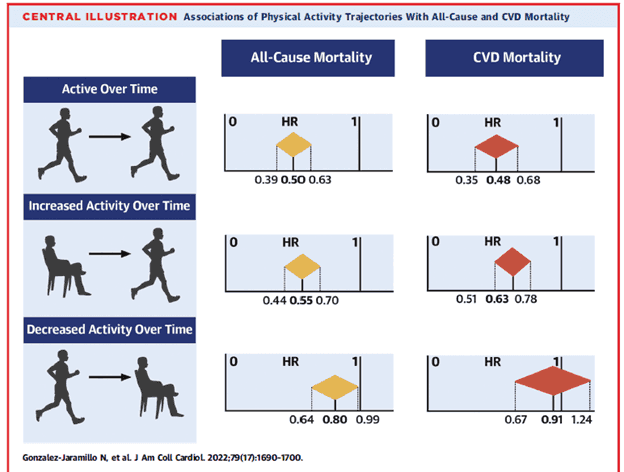
How much physical activity may reduce coronary heart disease patient’s mortality?
Patients with coronary heart disease (CHD) have an increased risk of both all-cause and cardiovascular disease mortality. Regular physical activity is a major modifiable protective factor against cardiovascular disease and death. Literature and Real-World evidence have repeatedly proven this.1,2
But one question remains unanswered. To go beyond the simple presence or absence of physical activity, what happens if a patient increases or decreases their physical activity over time?
A total of 9 publications (33,576 patients) were included in a recent systematic review and meta-analysis to evaluate the association of being inactive over time, active over time, increase activity over time, or decrease activity over time, with all cause and cardiovascular disease (CVD) mortality in patients with coronary heart disease (CHD).3
The results speak for themselves; compared with those who remained inactive, the risk of all-cause mortality was 50% lower for patients who remained active (HR:0.50; 95% CI: 0.39-0.63), 45% lower for those who increased their PA levels (HR: 0.55; 95% CI: 0.44- 0.70), and 20% lower for those who decreased their PA levels (HR: 0.80; 95% CI: 0.64-0.99). 3, Figure1
Figure1.

What can we learn from this? These findings suggest the protective effect of increased or continued physical activity and the potential harms of decreased activity or inactive lifestyle in CHD patients. It is also important to mention that the survival benefits are not solely dependent on past levels of activity but are combined with present levels of PA as well; patients with established CHD can overcome prior years of inactivity and obtain survival benefit like those who remained active!
Also, promoting physical activity should become part of the routine and treatment of CHD patient. In addition, therapeutic options exist to optimize the exercise capacity of CHD patients, for example in Chronic Coronary Syndrome (CCS) patients. Clinical evidence showed that, in addition to reducing angina attack by 81% in just 3 months, patients treated with Trimetazidine increased their exercise capacity by 4 METS.4 4,5 An analysis published in the New England Journal of Medicine, demonstrated that each additional MET is equivalent to a 12% increase in survival!6
METS* Metabolic Equivalent of Task
1. Jortveit J, Halvorsen S, Kaldal A, Pripp AH, Govatsmark RES, Langørgen J. Unsatisfactory risk factor control and high rate of new cardiovascular events in patients with myocardial infarction and prior coronary artery disease. BMC Cardiovasc Disord. 2019;19:71.
2. Lear SA, Hu W, Rangarajan S, et al. The effect of physical activity on mortality and cardiovascular disease in 130000 people from 17 high-income, middle-income, and low-income countries: the PURE study. Lancet. 2017;390:2643–2654.
3.. Systematic Review of Physical Activity Trajectories and Mortality in Patients With Coronary Artery Disease, JOURNAL OF THE AMERICAN COLLEGE OF CARDIOLOGY, VOL. 79, NO. 17, 2022
4. Effectiveness of Long-acting Trimetazidine in Different Clinical Situations in Patients with Stable Angina Pectoris: Findings from ODA Trial. Cardiol Ther. 2019 Jun;8¹:69-78. doi: 10.1007/s40119-019-0128-3. Epub 2019 Feb 18.
5. The role of metabolic therapy with trimetazidine in effort tolerance in patients with ischemic heart disease. Med Glas (Zenica). 2018 Aug 1;15²:109-114.
6. Exercise Capacity and Mortality among Men Referred for Exercise Testing. March 14, 2002. N Engl J Med 2002; 346:793-801
– For the exclusive use of healthcare professionals SCAC-08/22-DM-136-VAS SERVIER

Keep up to date with our content
Subscribe to our newsletter so that you are always up to date with the news.
